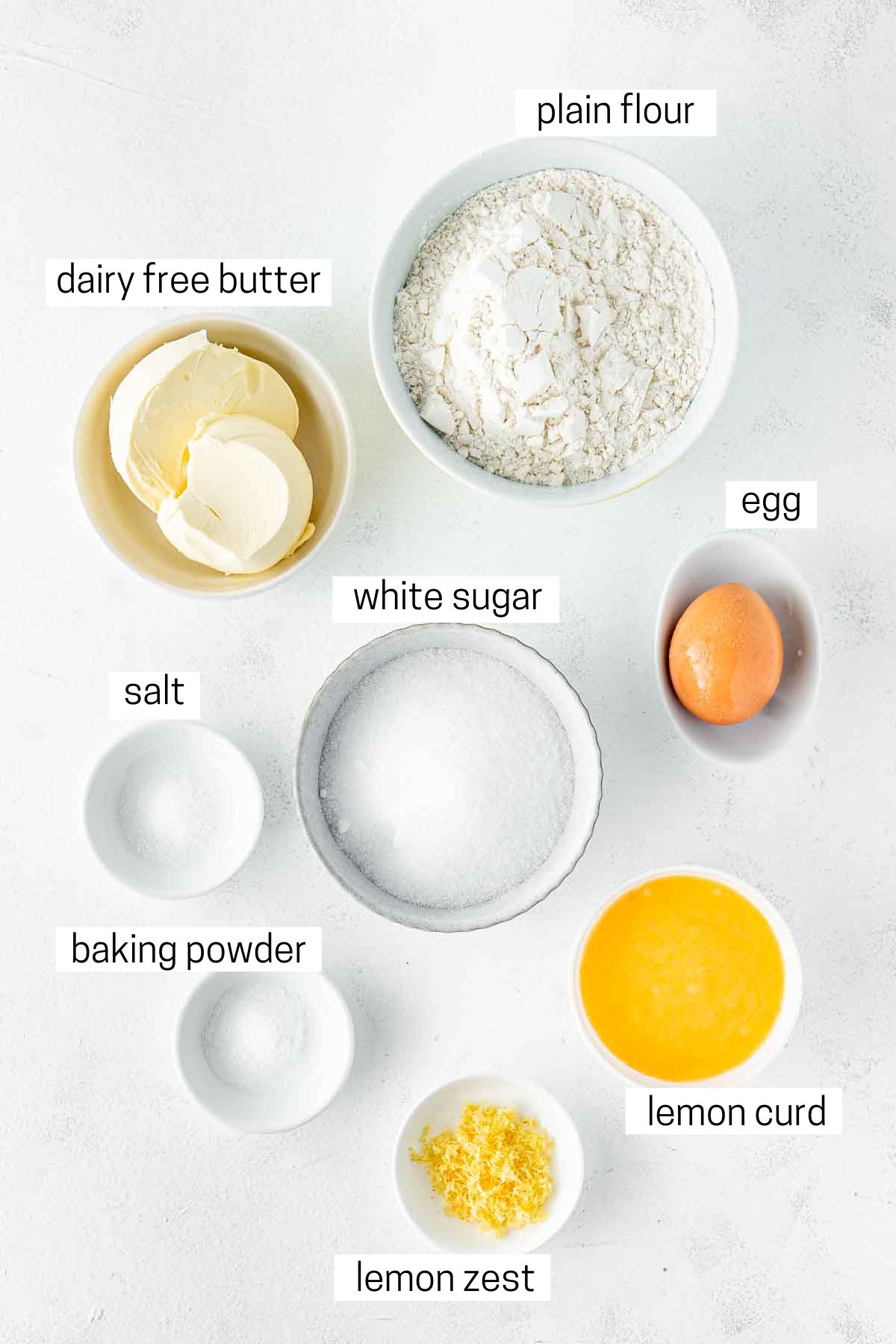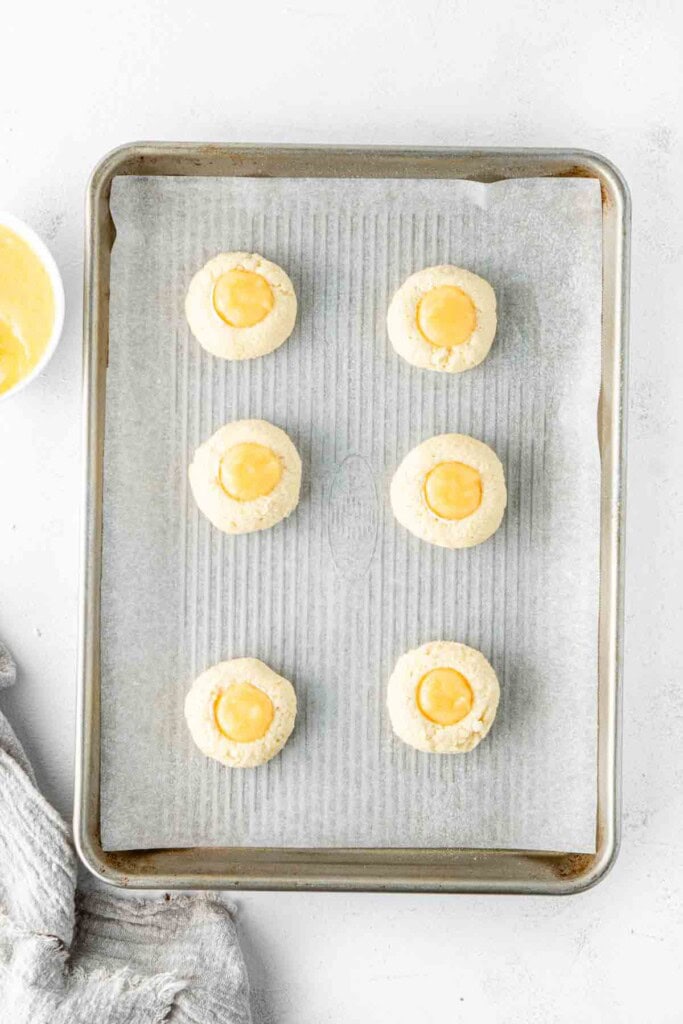These dairy free lemon thumbprint cookies are so simple and quick to make! With a simple, buttery cookie and homemade lemon curd filling, you’ll love the bright and tangy flavour of these cookies all year round.

These cookies are just like the beloved jam drop cookie, but instead of jam, we are using my homemade dairy free lemon butter for a tangy filling that works perfectly with the sweet, buttery shortbread cookie.
It’s totally optional, but I can never resist finishing them off with a little lemon glaze drizzle. The extra sweet/tangy combination just makes these cookies super addictive. Honestly, they are so incredibly easy to make but taste so good.
Sometimes, keeping things simple is the best, and these cookies really allow the lemon flavour to shine. So, if you’re a lemon lover like I am, you’re going to absolutely love these cookies!
While lemons are generally available year-round, we are coming into their peak season here in Australia over winter, so definitely make the most of this delicious citrus and start making all the lemony desserts.
I recommend making my dairy free lemon bars next because I still can’t stop thinking about them!
Key Ingredients
This is one of those cookie recipes that you can pretty much make using pantry staples, making it a great recipe for when you have some leftover lemon curd in the fridge.

Note: All ingredients and their quantities are laid out in the recipe card at the bottom of this post.
- Plain flour – Also known as all-purpose flour in the US. I haven’t tested this recipe with gluten-free flour, so cannot say that it would yield the same results. Please let me know if you try it!
- Baking powder – These are cakey cookies, so we want a little baking powder to puff up the cookies and keep them light.
- Dairy-free butter – Use a good quality vegan butter substitute for the best taste. I like to use Nuttelex Buttery, which is an Australian product, but I believe the best US alternative is Earth Balance.
- White sugar – To help keep our cookies sweet and also keep them soft.
- Egg – Helps hold the cookies together and provides that cakey texture. I haven’t tested these cookies with an egg replacement, so cannot say that it would yield the same results.
- Lemon – As these cookies are lemon-flavoured, I like to flavour the cookies themselves with a little lemon zest, but if you prefer, you can use 1 teaspoon of vanilla extract instead for flavouring.
- Lemon curd – Lemon butter or lemon curd, depending on where you live and what you call it, is going to be the filling for the cookies. You can use store-bought, but to keep these cookies dairy-free, I like to use my homemade lemon butter recipe. It’s super easy to make; just make sure it’s cooled down completely before using in these cookies.

Step-By-Step Instructions
These lemon thumbprint cookies are really quick and easy to make. You’ll need an electric mixer for your cookie dough. I prefer using my handheld mixer; I just think it’s easier for a recipe like this, but feel free to make them in your stand mixer if you prefer.
Start by combining your dry ingredients together so the baking powder and salt are distributed evenly through your plain flour.
Next, start beating together the dairy-free butter and the white sugar. Unlike baking with regular butter, we want the dairy-free butter straight out of the fridge as it’s generally much softer, so if allowed to warm up, it will result in our cookies spreading too much when baked.
Once the butter and sugar are combined, add in the egg and the lemon zest. Beat again until light and fluffy.


Add in the dry ingredients and continue to beat until a soft dough is formed. If it’s warm in your kitchen and the dough seems a bit soft, place the bowl in the fridge for about 30 minutes to allow the dough to firm up a little more to prevent the cookies from spreading too much.
Preheat the oven to 180°C (350°F) and line 2 trays with baking paper. Roll the cookie dough into balls and then place evenly on the trays, allowing enough room between them to spread.
Now to press indents into them for the filling. As the recipe name suggests, the common way to do this was to use your thumb to press an indent into the centre of each dough ball. However, I have found a much simpler way that isn’t impacted by my longer nails is to use a ½ teaspoon round measuring spoon dipped in flour instead.



TIP! Make the homemade lemon butter in advance so it has time to cool completely before you use it in these cookies. It will store in the fridge for around 2 weeks.
Fill the indents with ¼ – ½ teaspoon of the lemon butter before placing into the oven to bake for approximately 10-12 minutes. Every oven is different, so make sure to check at the earlier time. Your cookies shouldn’t be golden but rather just starting to change colour around the base. They will still be a little soft but will continue to firm up as they cool.
Once the cookies have cooled completely, you can make your lemon glaze and drizzle it over the tops. Allow the glaze to harden before stacking the cookies and storing.


Recipe FAQs
Yes, you can! These cookies are adapted from my raspberry thumbprint cookies. Basically, you can swap the lemon zest in the cookies for 1 teaspoon of vanilla extract and then use any jam you like for the filling.
Store these cookies in an airtight container at room temperature for up to 4-5 days. If you prefer, you can also refrigerate them to extend their freshness for up to a week. Just bring them to room temperature before serving to enjoy the best texture and flavour.
Yes, you can freeze the cookies once baked. Once they have completely cooled, place them in a single layer on a baking tray to freeze until solid. Then transfer the frozen cookies to an airtight container or freezer-safe bag, separating layers with parchment paper to prevent sticking.
The cookies can be frozen for 2-3 months. To enjoy, simply let them thaw at room temperature for a few hours or overnight.

More lemony desserts:
Vegan Lemon and Raspberry Loaf Cake
Lemon Layer Cake
Lemon Poppy Seed Muffins (Dairy-Free)
Pistachio Cardamom and Lemon Loaf Cake
Vegan Lemon Cupcakes
Vegan Lemon Poppy Seed Cake
Vegan Daisy Cake

Dairy Free Lemon Thumbprint Cookies
Ingredients
- 2 cups plain flour
- ½ teaspoon baking powder
- ¼ teaspoon salt
- 160 grams (⅔ cup) dairy-free butter
- ⅔ cup white sugar
- 1 large egg
- Zest of 1 lemon
- ⅓ cup lemon butter / lemon curd
For the glaze (optional):
- ¼ cup icing sugar
- ½ tablespoon lemon juice approx.
Instructions
- In a medium-sized bowl, whisk together the flour, baking powder, and salt, then set aside.
- In the bowl of an electric stand mixer or using a handheld mixer, beat the dairy-free butter and sugar until creamy. Add in the egg and lemon zest and continue beating until well combined.
- Add the dry ingredients to the bowl and beat on low until the dough starts to come together, scraping down the sides of the bowl with a spatula as necessary. The dough will be quite soft. Chill the dough for 30 minutes before baking to prevent the cookies from overspreading in the oven and to make them easier to roll.
- Preheat the oven to 180°C (350°F) and line 2 trays with baking paper. Using lightly floured hands, roll tablespoons of dough into balls and place them evenly on the trays, allowing enough room between them to spread.
- Using your thumb or a ½ teaspoon round measuring spoon, press an indent into the top of each cookie ball, pushing the edges out slightly. Fill the indent with ¼ – ½ teaspoon of the lemon butter. Repeat with all cookies.
- Bake for 10-12 minutes or until the edges just start to get a bit of color. Let cool on the tray for 10 minutes to firm up before transferring to a wire rack to cool completely.
- Make the glaze by mixing the icing sugar with a little lemon juice until the icing is just thin enough to drizzle over the cookies. Either drizzle over cooled cookies with a spoon or add to a piping bag with a small round piping tip attached. Let the glaze set and harden before storing cookies in an airtight container for up to 4-5 days.
Nutrition
Nutritional information is provided as a guide only and is calculated using automated online tools, therefore we cannot guarantee the accuracy. We encourage you to make your own calculations based on the actual ingredients used in your recipe.





Made this recipe? Leave a review!